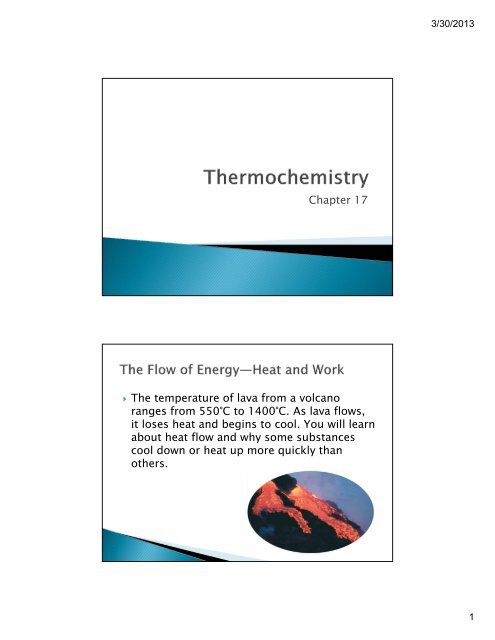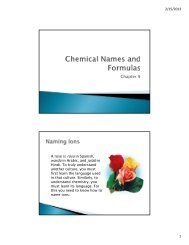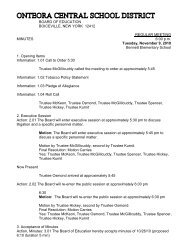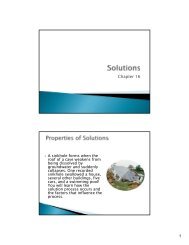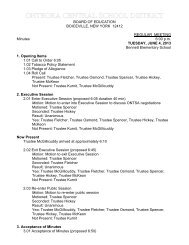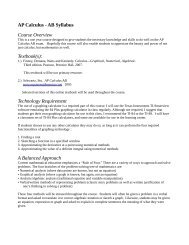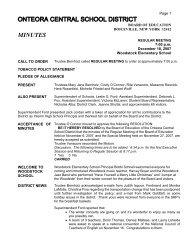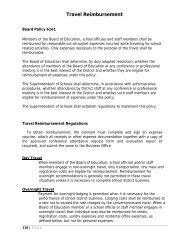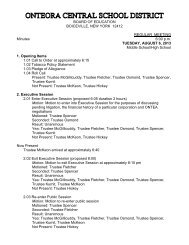Chapter 17 - Thermochemistry
Chapter 17 - Thermochemistry
Chapter 17 - Thermochemistry
Create successful ePaper yourself
Turn your PDF publications into a flip-book with our unique Google optimized e-Paper software.
3/30/2013• When fuel is burned in a car engine, chemical potentialenergy is released and is used to do work. Exothermic and Endothermic Processes◦ What happens in endothermic and exothermicprocesses?◦ In an endothermic process, the system gains heatas the surroundings cool down.◦ In an exothermic process, the system loses heat asthe surroundings heat up.3
3/30/2013• In studying energy changes, you can define a systemas the part of the universe on which you focus yourattention. The surroundings include everything else inthe universe.• The law of conservation of energy states that in anychemical or physical process, energy is neither creatednor destroyed.• An endothermic process is one that absorbs heat fromthe surroundings.4
3/30/2013• An exothermic process is one that releases heat to itssurroundings.5
3/30/2013 Units for Measuring Heat Flow◦ In what units is heat flow measured?• Heat flow is measured in two common units, thecalorie and the joule.• The energy in food is usually expressed in Calories.6
3/30/2013 Heat Capacity and Specific Heat◦ On what two factors does the heat capacity of anobject depend?• The heat capacity of an object depends on both itsmass and its chemical composition.• The amount of heat needed to increase the temperature ofan object exactly 1°C is the heat capacity of that object.• The specific heat capacity, or simply the specific heat,of a substance is the amount of heat it takes to raisethe temperature of 1 g of the substance 1°C.• Specific heat of water = 4.18 J/g-°C• ref. table B7
3/30/2013• Water releases a lot of heat as it cools. During freezingweather, farmers protect citrus crops by spraying themwith water.8
3/30/2013• Because it is mostly water, the filling of a hot apple pieis much more likely to burn your tongue than thecrust.9
3/30/2013 A burning match releasesheat to its surroundings inall directions. How muchheat does this exothermicreaction release? You willlearn to measure heat flowin chemical and physicalprocesses by applying theconcept of specific heat.10
3/30/2013 Calorimetry◦ What basic concepts apply to calorimetry?◦ Calorimetry is the precise measurement of the heatflow into or out of a system for chemical andphysical processes.• In calorimetry, the heat released by the system is equalto the heat absorbed by its surroundings. Conversely,the heat absorbed by a system is equal to the heatreleased by its surroundings.• Ref. table T – heat transfer equation:q = m x C x ∆T• q = heat absorbed or released• M = mass of water• C= specific heat• ΔT = temperature change11
3/30/2013◦ The insulated device used tomeasure the absorption or release ofheat in chemical or physicalprocesses is called a calorimeter.◦ The heat content of a system atconstant pressure is the same as aproperty called the enthalpy (H) ofthe system.◦ Constant-Volume Calorimeters• Calorimetry experiments can be performed at aconstant volume using a bomb calorimeter.12
3/30/2013 A small pebble is heated and placed in a foam cupcalorimeter containing 25.0 mL of water at 25.0°C.The water reaches a maximum temperature of26.4°C. How many joules of heat were released bythe pebble?13
3/30/2013 Thermochemical Equations• How can you express the enthalpy (heat) change for areaction in a chemical equation?• In a chemical equation, the enthalpy (heat) change for thereaction can be written as either a reactant or a product.• In exothermic reactions, heat is given off to thesurroundings, and shown as a product.• In endothermic reactions, heat is taken in from thesurroundings, and is shown as a reactant.• A chemical equation that includes the enthalpy changeis called a thermochemical equation.14
3/30/2013• The heat of reaction is the enthalpy change for thechemical equation exactly as it is written.• Exothermic reactions have a negative heat of reaction,and endothermic reactions have a positive heat ofreaction.• Reference table IExothermic Reaction15
3/30/2013Endothermic Reaction16
3/30/2013The production of iron and carbon dioxide from iron(III) oxideand carbon monoxide is an exothermic reaction. How manykilojoules of heat are produced when 3.40 mol Fe 2 O 3 reactswith an excess of CO? 3 → 2 3 26.3 <strong>17</strong>
3/30/2013• The heat of combustion is the heat of reactionfor the complete burning of one mole of asubstance.Referencetable I During a race, an athletecan burn a lot of caloriesthat either do work or arereleased as heat. Thissection will help you tounderstand how theevaporation of sweatfrom your skin helps torid your body of excessheat.18
3/30/2013 Heats of Fusion and Solidification◦ How does the quantity of heat absorbed by amelting solid compare to the quantity of heatreleased when the liquid solidifies?• The heat of fusion (H f ) is the heat absorbed by onegram of a solid substance as it melts to a liquid at aconstant temperature.• The heat of solidification (H s ) is the heat lost when onemole of a liquid solidifies at a constant temperature.• For water:H f = 334 J/gReference table B19
3/30/2013◦ The quantity of heat absorbed by a melting solid isexactly the same as the quantity of heat releasedwhen the liquid solidifies; that is, H f = -H s◦ To calculate heat gained during melting:• q = mH f• Reference table T20
3/30/2013How many kJ of heat are required to melt a 10.0 g popsicle at0°C? Assume the popsicle has the same molar mass and heatof fusion as water. Heats of Vaporization and Condensation◦ How does the quantity of heat absorbed by avaporizing liquid compare to the quantity ofheat released when the vapor condenses?21
3/30/2013• The amount of heat necessary to vaporize one mole ofa given liquid is called its heat of vaporization (H v ).• The amount of heat released when 1 mol of vaporcondenses at the normal boiling point is called its heatof condensation (H c ).• For water:H v = 2260 J/g◦ The quantity of heat absorbed by a vaporizingliquid is exactly the same as the quantity of heatreleased when the vapor condenses.◦ H v = –H c◦ To calculate heat gained during boiling:• q = mH v• Reference table T22
3/30/2013• Enthalpy changes accompany changes in state.23
3/30/201324
3/30/2013How many kJ of heat are absorbed when 0.46 g ofchloroethane (C 2 H 5 Cl, bp 12.3°C) vaporizes at its normal boilingpoint? The molar heat of vaporization of chloroethane is 26.4kJ/mol. Heat of Solution What thermochemical changes canoccur when a solution forms?• During the formation of a solution, heat is eitherreleased or absorbed.• The enthalpy change caused by dissolution of onemole of substance is the molar heat of solution(∆H soln ).• Reference table I25
3/30/2013• When ammonium nitrate crystals and water mix insidethe cold pack, heat is absorbed as the crystalsdissolve.26
3/30/2013How many moles of NH 4 NO 3 (s) must be dissolved in waterso that 88.0 kJ of heat is absorbed from the water? Emeralds are composed of theelements chromium, aluminum,silicon, oxygen, and beryllium.What if you wanted todetermine the heat of reactionwithout actually breaking thegems down to their componentelements? You will see how youcan calculate heats of reactionfrom known thermochemicalequations and enthalpy data.27
3/30/2013 Hess’s Law◦ What are two ways that you can determine the heatof reaction when it cannot be directly measured?• Hess’s law allows you to determine the heat of reactionindirectly.• Hess’s law of heat summation states that if you addtwo or more thermochemical equations to give a finalequation, then you can also add the heats of reactionto give the final heat of reaction.28
3/30/201329
3/30/2013 Standard Heats of Formation◦ For a reaction that occurs at standard conditions,you can calculate the heat of reaction by usingstandard heats of formation.• The standard heat of formation (∆H f0 ) of a compoundis the change in enthalpy that accompanies theformation of one mole of a compound from itselements with all substances in their standard states at25°C.• Reference table I30
3/30/2013• The Standard Heat of Formation of Water31
3/30/2013Calculate ∆H0 for the following reactions.a → b → c 2 → 2 32
3/30/201333


